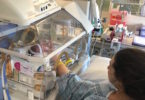Here’s how to increase your chances for conception…
In Vitro Fertilization, or IVF, is a modern method of conception available to help women who are having trouble getting pregnant. Simply put, IVF involves fertilization of the egg in a petrie dish, where it is allowed to sit and mature to an embryo before being implanted into the mother’s womb. IVF success rates hover around 40% for women over the age of 35. Older women with fewer eggs have a higher chance of getting pregnant thanks to IVF treatments.
However, you need to know that IVF treatments are very expensive. They can range from $12,000 to $17,000 per treatment. This includes the full course of hormones, the extraction of the egg, the fertilization, and the re-implantation of the embryo. The cost of a single IVF treatment means that many women are only able to try once. If the IVF doesn’t take on the first try, they have no way to afford another run at it.
According to a new study, having health insurance can play a large role in the IVF success rates. Researchers from Washington University found that the women with health insurance that covered IVF had a higher chance of actually getting pregnant.
Of course, the insurance itself had little to do with the IVF success rates. Instead, it simply enabled the women to continue undergoing treatment without having to fork over the money themselves. Of the 1,600 women participating in the study, 56% had health insurance that covered IVF. 70% of those insured women returned for a second IVF treatment when the first failed. The women without insurance had a lower return rate, thanks to the high costs.
But here’s the kicker: the more the women returned, the higher their IVF success rates. Success rates rose to 59% by the fourth treatment for the women with health insurance coverage, while it hovered around 51% for women without coverage. The higher chance of the women returning in a narrower treatment window led to an improvement in the IVF success rate.

READ MORE: What I Learned from My Frozen Embryo Transfer Experiences
If you’re considering undergoing IVF treatments, it’s a good idea to consider obtaining health insurance first. Specifically, health insurance that covers the IVF. That way, you’ll be able to keep coming back for treatments without having to wait months or years to save up. The closer-together treatments may increase your risk of a successful implantation and live birth.
But be warned: not all women’s health insurance will cover fertility procedures like IVF. You will need to read the fine print of your health insurance to determine what is and isn’t covered. You may get one or two tries at IVF, but the insurance may not cover repeated tries within the same year. It’s vital that you understand what your health insurance is offering to cover and what you have to pay out of your pocket.
If you can’t find a good insurance plan that covers the IVF treatments, it may be better to save up for multiple treatments before undergoing the first one. This “hedging your bets” that the first IVF treatment won’t succeed will raise your ultimate success rate. By undergoing multiple treatments in a shorter period of time, there may be a higher risk of it succeeding on the third or fourth try. You may be able to wait a few years—IVF success rates are at 40% among women over 35, and it will only decrease to 15% once you hit the age of 40. You have a year or two to save up or find good health insurance before you have to get started with IVF.








